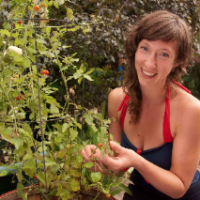Kate Leinweber, B.Sc R.H.N
Photo: Sweetbeetandgreenbean
I was once a proud vegan raw foodist.
For an intense two years, my diet consisted almost exclusively of raw fruits, vegetables, nuts and seeds, and as you can imagine adhering to such a strict dietary regimen was both challenging and demanding.
Food preparation alone nearly consumed my entire life. But during that time I was also working full time for a pharmaceutical company, practicing yoga daily and preparing meals for both my partner and myself. Needless-to-say, my body needed energy, and it needed it all the time—which meant my body needs carbs, a lot of them.
As a raw foodist on the go, the easiest and most accessible carbohydrate source was fruit, or, more specifically, bananas. I would eat up to eight bananas a day. I had bananas in my morning smoothie, bananas in my sprouted porridge, bananas for my afternoon snack and bananas in my (raw) ice cream for dessert. I didn’t buy bananas by the bunch; I bought them by the case. But my banana obsession ultimately didn’t meet my energy needs. Instead, it sent me on an exhausting cycle of blood sugar spikes and crashes, and that, in turn, left me deeply burnt out.
It wasn’t until one of my teachers asked me if I had tried cooked brown organic rice as an alternative energy source that my life started to change. Given my obsessive commitment to a raw foodist diet, I was skeptical of cooking anything—but somewhere inside me I knew that my lifestyle was unsustainable and I respected this woman. I figured I’d give it a shot.
The results were instant and dramatic. Within days I had more energy, I was noticeably stronger in my yoga practice and I felt more grounded, as if my head had finally returned to my body and my feet were planted back on the earth. What was the difference? Bananas are essentially a simple sugar, which rushes into the bloodstream and starts the cycle of spikes and crashes I was experiencing. But brown rice has protein, which helps to regulate blood sugar and stabilize energy use. Looking back, it took me a long time to understand what moderation and sustainable eating habits really meant—but that seemingly simple bowl of brown rice turned out to be my first step toward balance.
The important thing to understand is that Bananas were not the problem. It was my obsession with a perfect healthy diet that led to the overconsumption of sweet fruits. Fruit is a key part of our diet providing a matrix of nutrient.
What are Carbohydrates?
Carbohydrates equal quick energy. They’re easily broken down by the body and used for movement, cognition, immune system function, nervous system balance and cell-to-cell communication. In their simplest form, carbohydrates are simple sugars (like glucose or fructose); in their most complex, they are sugars like cellulose or fibre and indigestible by humans. Indigestible but oh so important to those morning visits at the porcelain throne.
Carbohydrate Sources
Carbohydrates are found in whole grains, legumes, vegetables and fruit. There are complex carbohydrates and simple carbohydrates. Complex carbohydrates include fruits, vegetables and whole grains (eg. whole wheat, brown rice, whole grain pasta, millet, quinoa, amaranth). Simple carbohydrates are the molecular components of complex carbohydrates and with the exception of fruits have usually been refined or processed (eg. Sugar, agave, corn syrups).
Refined carbohydrate sources (sugar, bread and baked goods made from refined grains, white rice and white pasta) have all been stripped of important nutrients. This is where the term “empty calories” comes from.
Shopping & Reading Food Labels
When buying breads or baked goods make sure to read the label and look for the words “Unrefined” or “Whole Wheat,” “Spelt,” “Rye.” Pasta choices are now available in a variety of different whole grains including kamut and brown rice.
Sugars in their different forms can be found on food labels. Read the Ingredients Listing and look for the ending “–ose” (eg. glucose, sucrose, fructose, maltose). Sugar alcohols are also frequent additives—look for the ending “–ol” (eg. maltitol, mannitol, sorbitol).
Alternatives
Alternatives to sugar used in cooking and baking are: maple syrup, raw unfiltered honey and molasses. The vitamins and minerals of these sugars remain intact. Stevia is a great choice when sugar must be restricted.






Read 20 comments and reply